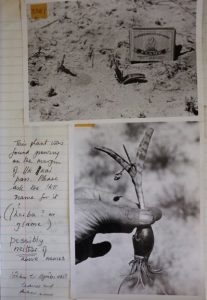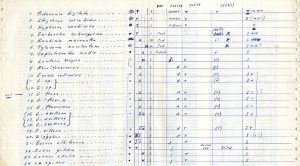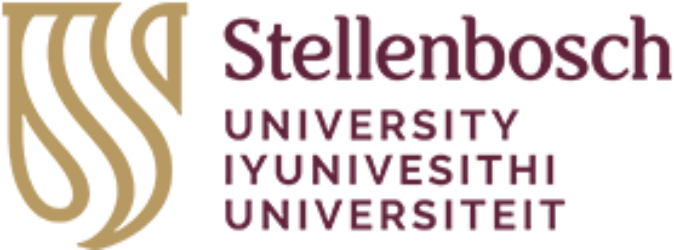[:en]A particularly valuable, rich and unique manuscript collection has recently been donated to the Stellenbosch University (SU) Library and Information Service. The Maguire San Ethnobotanical Collection consists of data collected by Mr Brian Maguire between 1954 and 1972 in close collaboration with Ju|’hoan (previously known as !Kung or !Khu) and ǃXoõ (previously known as !Kõ) communities in the Kalahari.
According to Dr Judy Maguire, her husband, Brian Maguire, became the field assistant to Prof Raymond Dart of “Australopithecus” fame in the 1960s and was researching the potential food plants of early hominids. “During this time he undertook comparative studies of the !Kõ hunter-gatherers in Central Western Botswana, especially as they were a group who had no annual, storable plant food staple to rely on such as the Manketti nuts of the !Kung (!Khu), and no permanent source of water either.

“Many hundreds of photographs were taken at this time, in the context of food gathering, the plant communities of economically important food and medicinal plants, the plants themselves as well as the parts that are eaten. Food preparation was also photographed. It was already apparent at this time that acculturation was taking its toll.
“Prior to this time, Maguire had gained experience as ethnobotanist to the Brock-Harvard-Peabody medical and the Marshall ethnological excursions to the !Kung of SWA during the 1950s, at a time when almost nothing had been recorded concerning the food and medicinal plants of indigenous populations.
“Subsequently, Brian Maguire (1978) completed an MSc (cum laude) entitled The Food Plants of the !Khu Bushmen of North Eastern South West Africa (Namibia). The work was undertaken at a time when little if anything was known about the subsistence ecology of the !Kung, and observations were made at a time when acculturation and impacts on their food-gathering practices were minimal. He died prematurely whilst busy with a Ph.D. on the !Kõ subsistence ecology and finalising the work on the potential vegetable dietary of early hominids in the then Transvaal.”
The collection, consisting of manuscripts, typescripts, sketches, diagrams, photographic prints, black and white negatives, colour slides, field notebooks and plant collection registers, is of great scientific, research, national and heritage importance. It was the wish of the late Mr Maguire and is still the wish of Dr Judy Maguire that the collection becomes a usable resource which can be shared with younger generations. It offers the opportunity to learn from our forefathers about the sustainable use our indigenous plants in an African context.

A significant portion of the physical collection has been digitised and these digital records will be made openly available for research purposes on the Library’s Digital Heritage Repository, SUNDigital Collections. The addition of the collection will ideally complement other digital heritage and natural heritage collections currently on the repository such as the Rudolf Marloth botanical illustrations collection and the James Walton vernacular architecture collection, which includes information and images of various artefacts of Southern African indigenous people.
The physical collection will be hosted in the Manuscript Section of the Special Collections division in the Library in due course. Once again, the collection will enrich current holdings and complement collections such as the Robert Broom, John Muir, BIC van Eeden and Jan Anthonie Engelbrecht collections, all of which relate to indigenous botany, zoology, languages and early customs.
Dr Maguire believes that the knowledge locked in the collection can be used to “assess the attrition of indigenous knowledge systems, and to achieve a better understanding of the context of knowledge transmission – its connection to language loss for example (plant names) and to understand what factors could help to preserve the transmission of knowledge before it disappears with increasing modernisation and acculturation of communities”.
The comprehensive, meticulously documented collection was brought to the attention of the Library by Dr Kerry Jones, Research Associate at SU and Postdoctoral Researcher in Linguistics at Rhodes University. Dr Jones was instrumental in the sorting and digitisation of the collection in collaboration with Dr Maguire and will continue to work on the collection in collaboration with mother tongue speakers in the future.
Liaise with Mimi Seyffert-Wirth, Deputy Director: Digital Scholarship (Library and Information Service) at mseyf@sun.ac.za for more information.
Mimi Seyffert-Wirth[:af]’n Besonder waardevolle, ryk en unieke manuskripversameling is onlangs aan die Universiteit Stellenbosch se Biblioteek- en Inligtingsdiens geskenk. Die Maguire San etnobotaniese versameling bestaan uit data wat tussen 1954 en 1972 deur mnr Brian Maguire, in noue samewerking met die Ju|’hoan (voorheen bekend as !Kung of !Khu) en ǃXoõ (voorheen bekend as !Kõ)-gemeenskappe in die Kalahari.
Volgens dr Judy Maguire het haar man, Brian Maguire, in die 1960’s professor Raymond Dart van “Australopithecus”-faam se veldassistent geword en navorsing gedoen oor die potensiële voedselplante van vroeë hominiede. “Gedurende hierdie tyd het hy vergelykende studies onderneem van die !Kõ versamelaar-jagters in sentraal-wes-Botswana, veral aangesien hierdie groep geen jaarlikse, stoorbare stapel- plantvoedsel gehad het waarop hulle kon staatmaak soos die manketti-neute van die !Kung (!Khu) nie, en ook geen permanente waterbron nie.

“Honderde foto’s is in hierdie tyd geneem, in die konteks van voedselversameling, die plantgemeenskappe van ekonomies belangrike voedsel, medisinale plante, die plante self sowel as die eetbare dele. Die voorbereiding van voedsel is ook afgeneem. Dit was reeds duidelik dat akkulturasie besig was om sy tol te eis.
“Voor dit het Maguire ondervinding opgedoen as etnobotanikus vir die Brock-Harvard-Peabody mediese en die Marshall etnologiese ekskursies na die !Kung van SWA gedurende die 1950’s. Dit was ‘n stadium waar byna niks rondom voedsel en medisinale plante van inheemse bevolkingsgroepe opgeteken was nie.
“Brian Maguire het daarna (1978) sy MSc (cum laude) voltooi met die titel The Food Plants of the !Khu Bushmen of North Eastern South West Africa (Namibia). Toe die werk onderneem is, was baie min bekend oor die bestaansekologie van die Kung en waarnemings is gemaak in ’n tyd toe daar minimale akkulturasie en invloede op hul voedselversamelpraktyke was. Hy is ontydig dood terwyl hy besig was met sy PhD oor die bestaansekologie van die !Kõ en met die finalisering van die werk oor die potensiële groentedieet van vroeë hominiede in die destydse Transvaal.”
Die versameling, bestaande uit manuskripte, tikwerk, sketse, diagramme, gedrukte foto’s, wit-en-swart negatiewe, kleurskyfies, veldnotaboeke en registers van plantversamelings is van groot wetenskaplike, navorsings- en erfeniswaarde. Dit was wyle mnr Maguire se wens, en ook dié van dr Judy Maguire, dat die versameling ’n bruikbare hulpbron moet word wat met jonger geslagte gedeel kan word. Dit bied die geleentheid om van ons voorouers te leer oor die volhoubare gebruik van ons inheemse plante in ’n Afrika-konteks.

’n Beduidende deel van die fisiese versameling is gedigitaliseer en hierdie digitale rekords sal openlik vir navorsingsdoeleindes in die Biblioteek se digitale erfenisbewaarplek, SUNDigital Collections, beskikbaar gestel word. Die toevoeging van die versameling sal ideaal gesien die ander digitale erfenis- en natuurerfenisversamelings wat reeds in die bewaarplek is, aanvul. Voorbeelde van sodanige versamelings is die Rudolf Marloth versameling van botaniese sketse en die James Walton versameling van streeksargitektuur, wat inligting en beelde van verskeie artefakte van Suider-Afrikaanse inheemse bevolkings insluit.
Die fisiese versameling sal mettertyd in die Dokumentesentrum van die Afdeling Spesiale Versamelings in die Biblioteek gehuisves word. Hier sal dit ook huidige versamelings, soos dié van Robert Broom, John Muir, BIC van Eeden en Jan Anthonie Engelbrecht verryk en aanvul. Hierdie versamelings hou almal verband met inheemse plantkunde, dierkunde, tale en vroeë gebruike.
Dr Maguire glo dat die kennis wat in die versameling opgesluit is, gebruik kan word om “die natuurlike uitvloei van inheemse kennisstelsels te bepaal en om die konteks van kennisoordrag beter te verstaan – die verband met bv. taalverlies (plantname) en om te verstaan watter faktore kan help om die kennis te bewaar voordat dit verdwyn as gevolg van toenemende modernisasie en akkulturasie van gemeenskappe.”
Die omvattende, noukeurig gedokumenteerde versameling is onder die Biblioteek se aandag gebring deur dr Kerry Jones, navorsingsgenoot aan die Universiteit Stellenbosch en postdoktorale navorser in taalwetenskap aan die Rhodes-universiteit. Dr Jones het saam met Dr Maguire gehelp met die sorteer en digitalisering van die versameling.
Skakel met Mimi Seyffert-Wirth, Adjunkdirekteur: Digitale Akademieskap (Biblioteek- en Inligtingsdiens), by mseyf@sun.ac.za.
Mimi Seyffert-Wirth[:]
